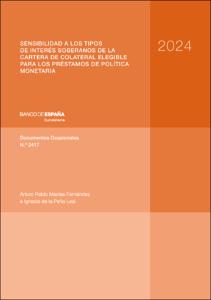Registro completo de metadatos
| Campo DC | Valor |
|---|---|
| dc.contributor.author | Macías, Arturo |
| dc.contributor.author | Peña Leal, Ignacio de la |
| dc.coverage.spatial | España |
| dc.date.accessioned | 2024-05-21T10:38:41Z |
| dc.date.available | 2024-05-21T10:38:41Z |
| dc.date.issued | 2024-05-23 |
| dc.identifier.issn | 1696-2230 (en línea) |
| dc.identifier.issn | 1696-2222 (en papel) |
| dc.identifier.uri | https://repositorio.bde.es/handle/123456789/36612 |
| dc.description.abstract | Since 2022, interest rates and yields on Spanish Treasury bonds have increased sharply. From the perspective of monetary policy implementation, rate increases imply a reduction in the market value of marketable assets used as collateral in Eurosystem credit operations. In this context, this article has three objectives: firstly, to analyse and understand the evolution of the two components of the Spanish sovereign interest rate curve (the risk-free rate and the Spanish sovereign spread) from a historical perspective, for which the empirical term structure of the sovereign spreads of three southern European countries (Spain, Portugal and Italy) is presented. Secondly, the impact of these interest rates on a relevant subset of Spanish fixed income instruments (ECB eligible assets) is statistically analysed. Finally, the models developed are used to simulate how five stress scenarios affecting the components of the Spanish interest rate curve would impact the availability of collateral for Eurosystem’s monetary policy operations. The result of the simulation suggests that the two components of sovereign interest rates have very different impacts: the scenario of a 200 basis points (bp) increase in the risk-free rate (at the ten-year maturity tenor) implies a reduction in available collateral of 1.4%, while the scenario of a 200 bp increase in the sovereign spread implies a contraction of 5.1%. This is due to the weight of variable coupon bonds (78%) in the pledged collateral portfolio, which makes its value largely impervious to changes in the risk-free rate. The abundance of variable coupon bonds means that even the risk-free rate rising to its historical maximum would only imply a contraction of available collateral of 3.2%. However, adding stress to the sovereign spread increases the impacts substantially: i) combining the two increases of 200 bp reduces the collateral volume by 6.2%, and ii) combining the maximum risk-free stress and the sovereign stress of 200 bp results in a contraction of 7.8% in pledged collateral (in fact, in the case of fixed coupon assets with a duration of more than 10 years, around half of the collateral is lost). |
| dc.description.abstract | Desde 2022, los tipos de interés y las rentabilidades de los bonos del Tesoro español se han incrementado de forma acusada. Desde la perspectiva de la implementación de la política monetaria, las subidas de tipos implican una reducción del valor de mercado de los activos negociables utilizados como colaterales para las operaciones de crédito del Eurosistema. En este contexto, el presente artículo se plantea tres objetivos: en primer lugar, analizar y entender la evolución de los dos componentes de la curva del tipo de interés soberano español (el tipo de interés libre de riesgo y el diferencial soberano español) desde una perspectiva histórica, para lo que se presenta la estructura temporal empírica de los diferenciales de crédito de las curvas soberanas de tres países de Europa meridional (España, Portugal e Italia). En segundo lugar, se analiza estadísticamente el impacto de estos tipos de interés sobre un subconjunto relevante de los instrumentos españoles de renta fija: los elegibles para su descuento en el banco central. Finalmente, utilizando los modelos desarrollados, se simula el impacto de cinco escenarios de estrés de los componentes del tipo de interés español sobre la disponibilidad de colateral para las operaciones de política monetaria del Eurosistema. |
| dc.format.extent | 36 p. |
| dc.language.iso | es |
| dc.publisher | Banco de España |
| dc.relation.ispartof | Documentos Ocasionales / Banco de España, 2417 |
| dc.rights | Reconocimiento-NoComercial-CompartirIgual 4.0 Internacional (CC BY-NC-SA 4.0) |
| dc.rights | In Copyright - Non Commercial Use Permitted |
| dc.rights.uri | https://creativecommons.org/licenses/by-nc-sa/4.0/deed.es_ES |
| dc.rights.uri | http://rightsstatements.org/vocab/InC-NC/1.0/ |
| dc.subject | Term structure of credit risk |
| dc.subject | Sovereign spreads |
| dc.subject | Collateral for monetary policy operations |
| dc.subject | Estructura temporal del riesgo de crédito |
| dc.subject | Diferenciales soberanos |
| dc.subject | Colateral para operaciones de política monetaria |
| dc.subject | Bonos |
| dc.subject | Tipos de interés |
| dc.subject | Riesgo de crédito |
| dc.subject | Política monetaria |
| dc.title | Sensibilidad a los tipos de interés soberanos de la cartera de colateral elegible para los préstamos de política monetaria |
| dc.type | Documento de trabajo |
| dc.identifier.bdebib | 000475598 |
| dc.identifier.bdepub | DOCA-202417-spa |
| dc.subject.bde | Mercados financieros |
| dc.publisher.bde | Madrid : Banco de España, 2024 |
| dc.subject.jel | E44 |
| dc.subject.jel | G12 |
| dc.subject.jel | G15 |
| dc.subject.jel | G17 |
| dc.identifier.doi | https://doi.org/10.53479/36612 |












